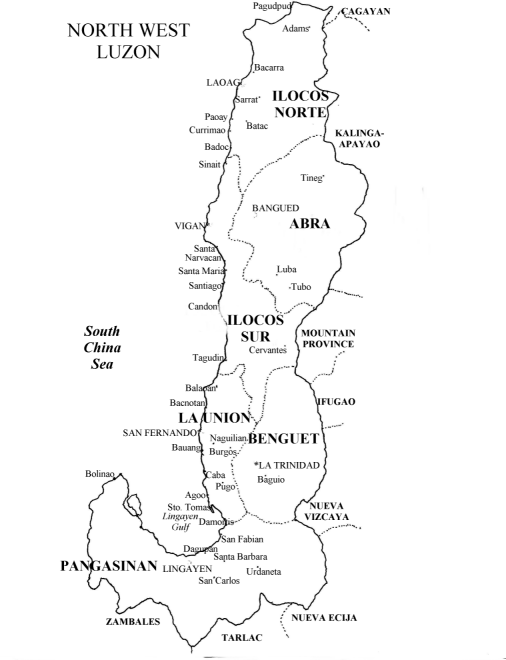
Alta
Arta (12 speakers left)
Balangao
Bontok
Casiguran Dumagat
Palanan Dumagat
Umirey Dumagat
Gaddang
Ibanag
Ibaloi
Ifugao
ILOKANO (Ilocano)
Ilongot
Isneg
Isinay
Itneg
Itawis
Kalinga
Kallahan
Kankanaey
Pangasinan
Paranan
Yogad

 |
Adasen
Alta Arta (12 speakers left) Balangao Bontok Casiguran Dumagat Palanan Dumagat Umirey Dumagat Gaddang Ibanag Ibaloi Ifugao ILOKANO (Ilocano) Ilongot Isneg Isinay Itneg Itawis Kalinga Kallahan Kankanaey Pangasinan Paranan Yogad |
The original Ilocano homeland is in Northwest Luzon (the provinces of Ilocos Norte, Ilocos Sur, Abra, and La Union), but Ilocanos have populated many regions of the Philippines, and in many cases they predominate over the native ethnic group of the new lands to which they migrate. Such is the case in the provinces of Nueva Ecija, Pangasinan, Tarlac, and Benguet. There are also sizable communities of Ilocanos throughout the United States, most notably in HAWAII and CALIFORNIA where the language is taught in certain schools.
Because of the importance of Ilocano in Northern Luzon, it has been called the "National Language of the North." Many ethnic groups from the northern regions of the country are more at home in their second language, Ilocano, than the national language of the country, Tagalog (Pilipino). This is undoubtedly due to the historical prestige of the language and the accessibility of its speakers. There has been a national language shift, however, in the last few years due to the extensive use of Tagalog in the media and the national program to promote the Pilipino language in elementary and secondary schools. Ilocano remains a regional langauge with no political power or use in education past the early elementary years.
ILOCANO DIALECTS. Because of the remarkably stable history of the Ilocano language owing to the fact that the Ilocano people have populated much of the Kailokuan from a small homogeneous homeland, dialect diversity is minimal. The original Ilocano speaking areas (in the provinces of Ilocos Norte and Ilocos Sur) are said to speak the "purest" form of the language, called by Ilocanos 'nauneg nga Iloko' (deep Ilocano). However, due to the migration of the Ilocanos southward and eastward, much of northern Luzon is heavily influenced by Ilocano language and culture. La Union and Pangasinan provinces are dominated in most areas by Ilocano speakers speaking the southern dialect. The southern dialect has minimal lexical differences from the northern one, but a major phonological difference-- the addition of a high back unrounded vowel represented in the orthography by the letter 'e'. As this sound exists also in Pangasinan, we might be able to attribute this difference as a remnant left behind by ethnic Pangasinenses who are now mother tongue speakers of Ilocano.
OTHER PHILIPPINE LANGUAGES. The Philippines
is a country of remarkable linguistic diversity.
There are over ninety languages spoken in the country, but only seven
are considered important and have an extensive written literature and history.
These are (in order of the number of speakers) Cebuano, Tagalog, Ilocano
(Iloko), Hiligaynon (Ilongo), Bikol, Waray Waray (Samar-Leyte Bisaya),
Pampango (Kapampangan), and Pangasinan. All the languages of the archipelago
are Western Austronesian of the Philippine type except the languages left
behind by colonization: English, Spanish, and the language of a powerful
merchant class, Hokkien Chinese. A Spanish Creole, Chavacano, is still
spoken today in Zamboanga, Mindanao, and to a lesser extent in Cavite City.
|
Do you know these Ilocano words? Click here to see a sample of the pre-Hispanic Ilocano syllabary as used in the 1621 Ilocano Doctrina Cristiana. |
Source:
Rubino, Carl. 1998. Ilocano
Phrasebook and Dictionary. New York: Hippocrene Books. [excerpts from
pages 7 and 8]
Map from Rubino, Carl. 2000. Ilocano Grammar
and Dictionary. Honolulu: University of Hawaii Press.